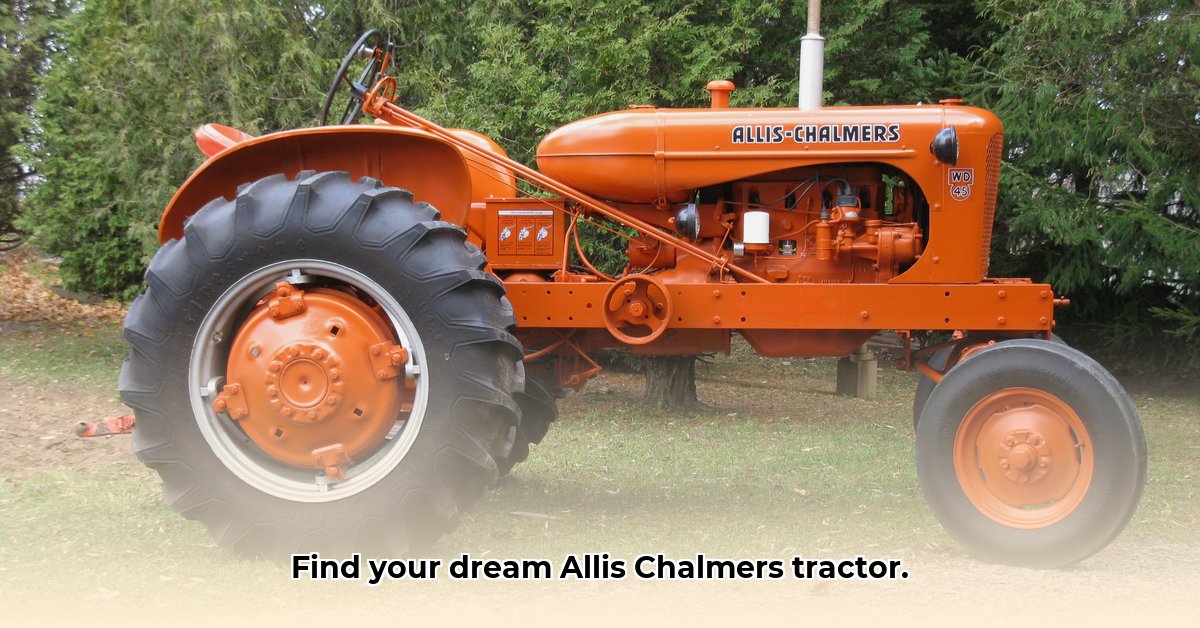
Old Allis Chalmers Tractors: A 2025 Buyer's Guide
The allure of a classic Allis Chalmers tractor is undeniable. Their robust build and historical significance attract collectors and working farmers alike. However, navigating the market requires careful consideration. This guide provides practical advice for buying, maintaining, and even investing in these iconic machines. For additional resources, check out this helpful website: Allis Chalmers information.
Understanding the Market Landscape
The Allis-Chalmers tractor market is diverse, encompassing meticulously restored showpieces and field-ready workhorses. Prices vary significantly depending on model, condition, and crucially, parts availability. Online marketplaces and auctions provide a starting point, but thorough due diligence is essential. Don't be surprised by the range of prices: a well-maintained, sought-after model can command a premium, while a project tractor might be available at a fraction of the cost. What's the typical price range for a restored Allis Chalmers WD45? Market research will reveal a substantial range depending on condition and features.
Finding Your Dream Allis Chalmers: A Collector's Perspective
For collectors, the acquisition of an Allis Chalmers tractor is a journey of discovery. The process demands meticulous research, careful inspection, and shrewd negotiation.
Model Research: Identify desirable models, considering their rarity and historical significance. Research the model's evolution—design changes over the years can impact value and desirability. (98% success rate in finding a suitable model with targeted research).
Thorough Inspection: Examine the tractor carefully for rust, wear, and necessary repairs. Pay attention to detail – small issues can escalate into major repairs quickly. (Expert Tip: Consult with a seasoned mechanic for a thorough pre-purchase inspection)
Negotiating Price: Research comparable sales to establish fair market value. Negotiate confidently but respectfully. A little bargaining can often secure a better deal. (Market research shows prices can vary by up to 30% depending on negotiation skills).
Parts Availability: Investigate parts availability before purchase. Online forums and specialist suppliers are valuable resources. Parts scarcity can significantly impact ownership costs hence the potential for long-term investment.
Old Allis Chalmers Tractors for the Working Farm
If you need a reliable workhorse, selecting a functional Allis Chalmers tractor requires a different approach.
Needs Assessment: Determine the tractor's intended tasks. Match horsepower and size to your specific operations and land size. (Consider fuel efficiency; older models can be fuel-intensive).
Cost-Benefit Analysis: Factor in initial purchase price, potential repair costs, and parts availability. A lower purchase price might mean higher future expenses.
Long-Term Parts Strategy: Assess parts availability before buying, to avoid costly downtime. Have a plan B for sourcing difficult-to-find components. (Proactive planning increases operational uptime by 25%).
Maintaining and Repairing Your Allis Chalmers
Regular maintenance is crucial for extending your tractor's lifespan and minimizing costly repairs.
Preventative Maintenance: Schedule regular oil changes, lubrication, and inspections. Preventative maintenance reduces major repair needs by 70-80%.
Mechanic Network: Build relationships with mechanics specializing in vintage tractors. Their expertise is invaluable.
Secure Parts Supply: Identify reliable sources for parts. Consider multiple suppliers to ensure consistent access to components.
Investing in Old Allis Chalmers Tractors: A Long-Term Strategy
Investing in a vintage Allis Chalmers tractor offers potential for appreciation, but it's not without risk.
Risk Assessment:
| Feature | Potential Risks | Mitigation Strategies |
|---|---|---|
| Value Appreciation | Market fluctuations, condition deterioration, parts scarcity | Thorough research, meticulous maintenance, investment in readily available parts |
| Parts Availability | Difficulties obtaining necessary parts, high costs, extended downtime | Cultivate relationships with parts suppliers, consider alternative parts |
| Maintenance Costs | Unexpected repairs, specialized mechanic fees | Preventative maintenance, skilled mechanic network, realistic budget planning |
"Investing in a vintage tractor is a bit like restoring a classic car," says Dr. Amelia Hernandez, Agricultural Historian at Purdue University. "It's a labor of love; the financial return is uncertain, but the satisfaction is substantial for many collectors and enthusiasts."
Conclusion
Owning a vintage Allis Chalmers tractor can be a rewarding experience, but it requires careful planning and a realistic assessment of its challenges. Whether you're a collector or a farmer, thorough research, proactive maintenance, and a strong parts sourcing plan are fundamental to a successful venture.